Leadership Styles and Analysis
VerifiedAdded on 2020/03/16
|15
|5006
|69
AI Summary
This assignment delves into the multifaceted world of leadership in various organizational contexts. It encourages an examination of different leadership styles, theories, and frameworks. Students are tasked with critically analyzing the influence of leadership on organizational effectiveness, exploring ethical considerations, and considering contemporary challenges in leadership development.
Contribute Materials
Your contribution can guide someone’s learning journey. Share your
documents today.
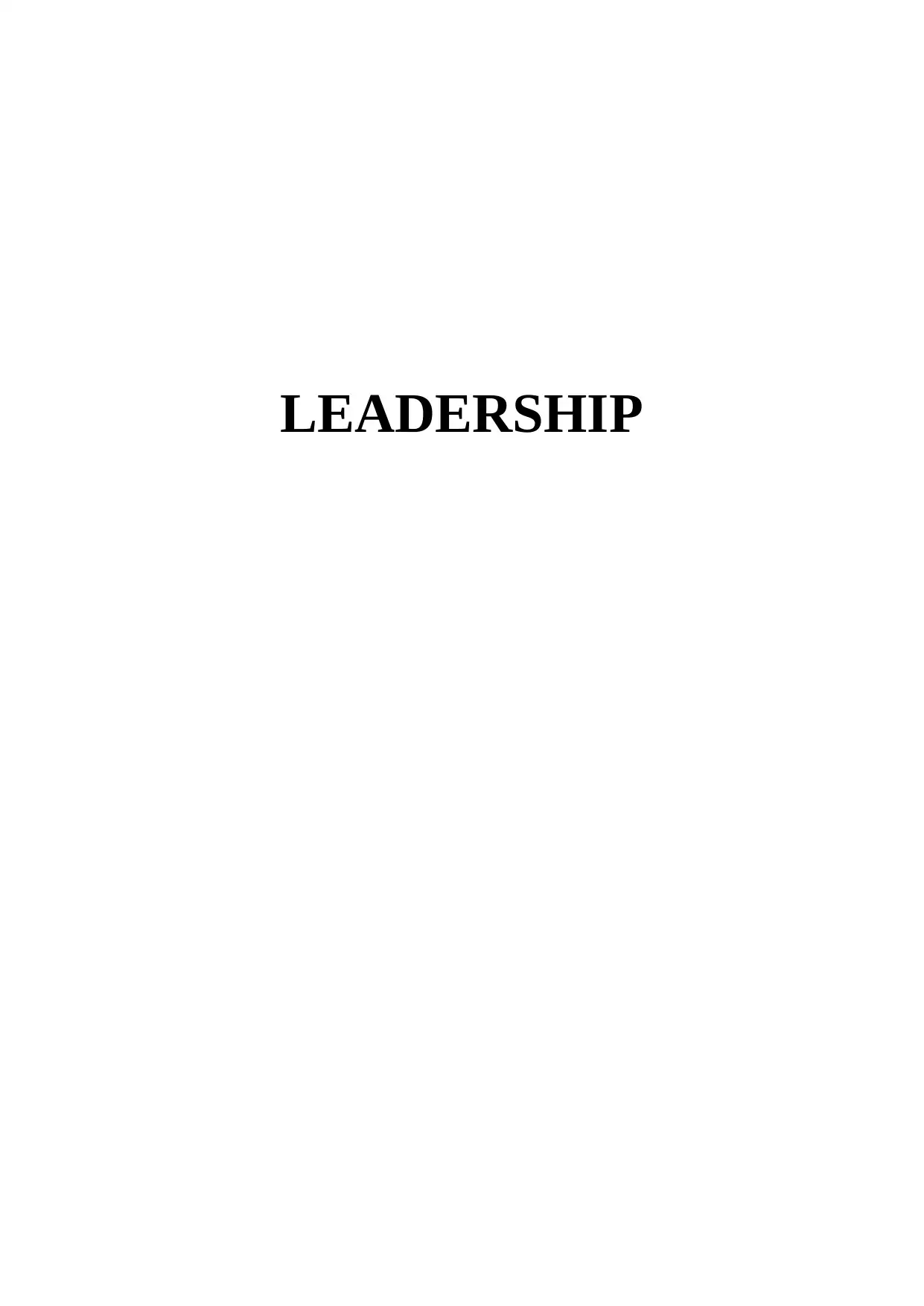
LEADERSHIP
Secure Best Marks with AI Grader
Need help grading? Try our AI Grader for instant feedback on your assignments.
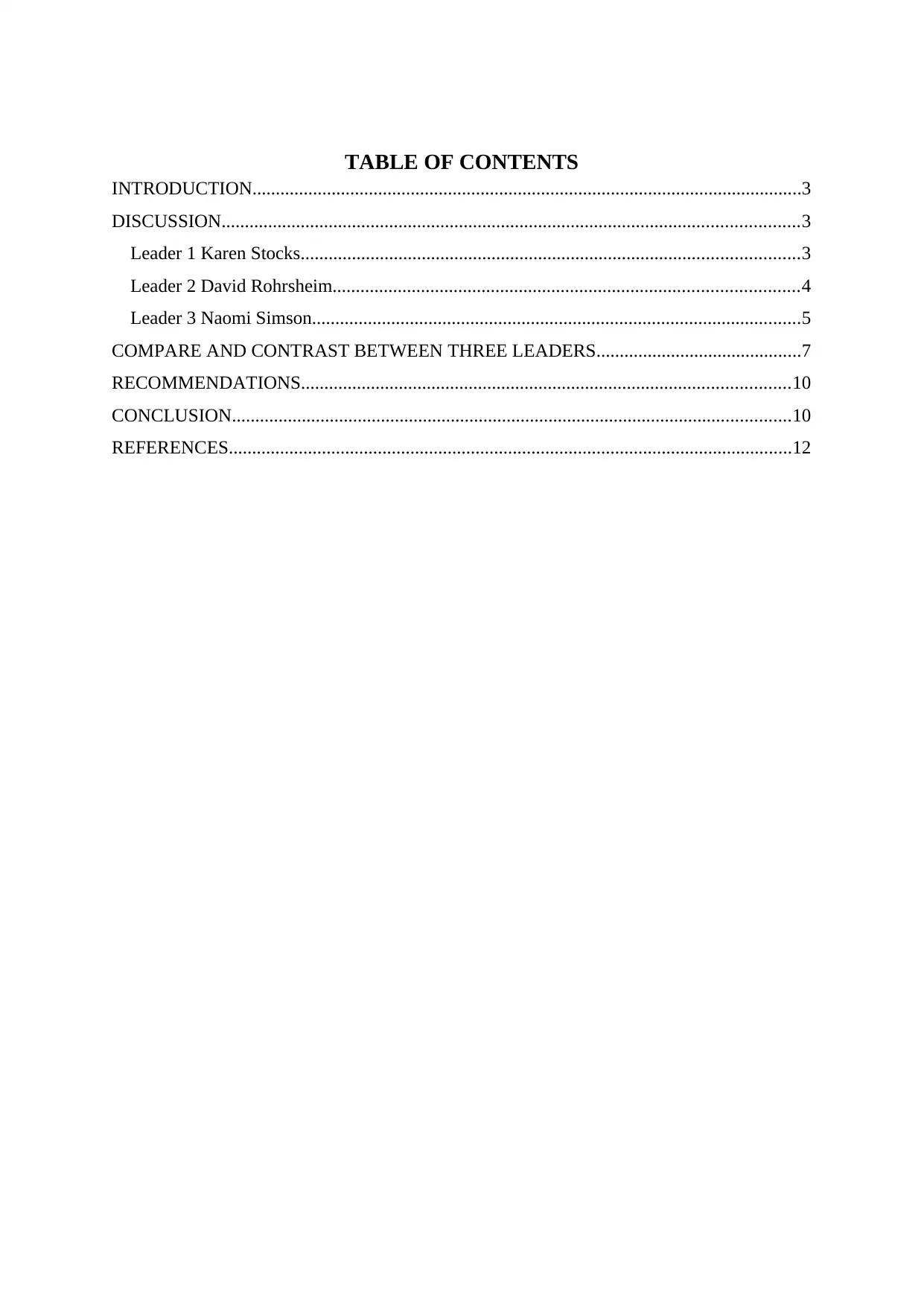
TABLE OF CONTENTS
INTRODUCTION......................................................................................................................3
DISCUSSION............................................................................................................................3
Leader 1 Karen Stocks...........................................................................................................3
Leader 2 David Rohrsheim....................................................................................................4
Leader 3 Naomi Simson.........................................................................................................5
COMPARE AND CONTRAST BETWEEN THREE LEADERS............................................7
RECOMMENDATIONS.........................................................................................................10
CONCLUSION........................................................................................................................10
REFERENCES.........................................................................................................................12
INTRODUCTION......................................................................................................................3
DISCUSSION............................................................................................................................3
Leader 1 Karen Stocks...........................................................................................................3
Leader 2 David Rohrsheim....................................................................................................4
Leader 3 Naomi Simson.........................................................................................................5
COMPARE AND CONTRAST BETWEEN THREE LEADERS............................................7
RECOMMENDATIONS.........................................................................................................10
CONCLUSION........................................................................................................................10
REFERENCES.........................................................................................................................12
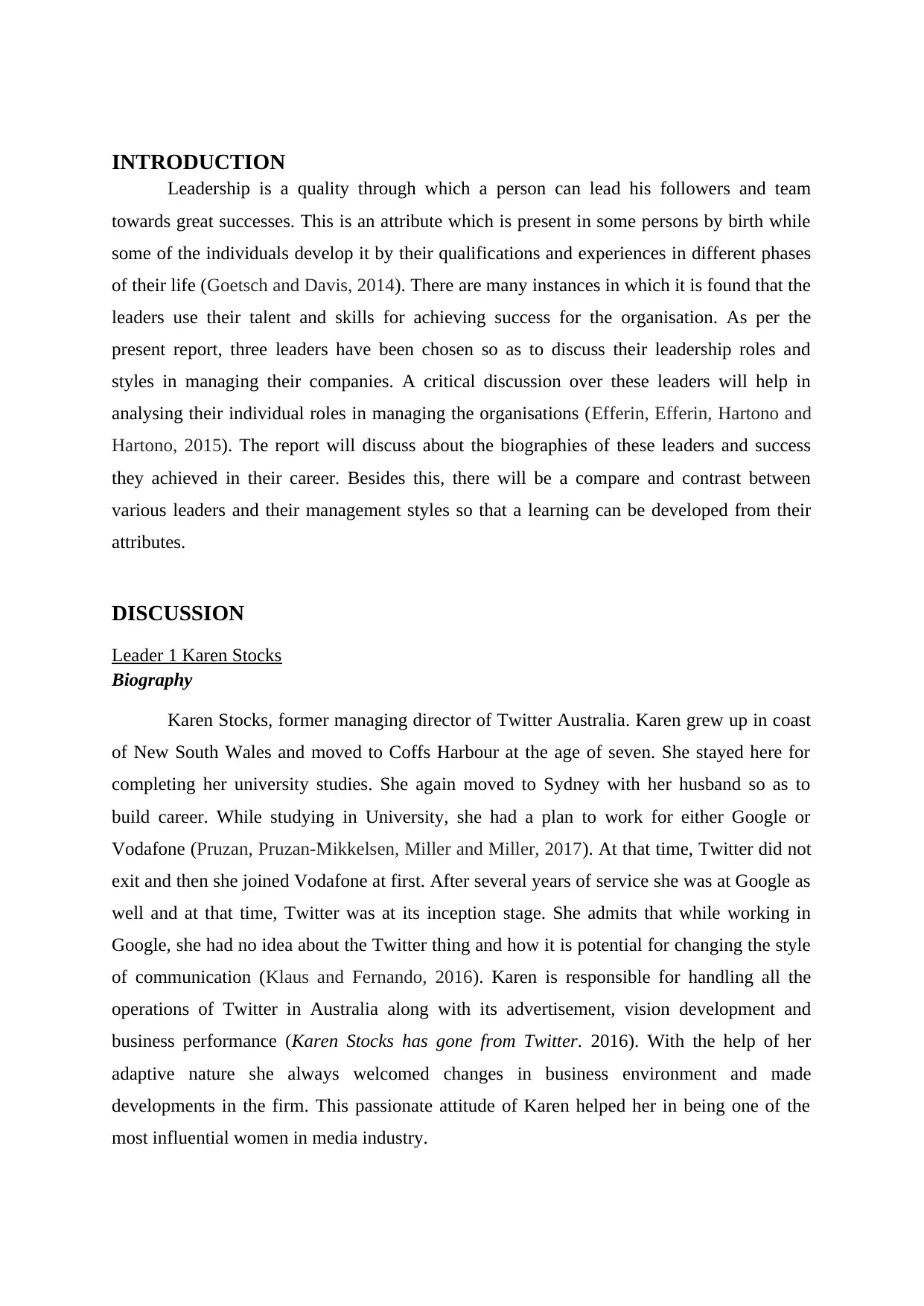
INTRODUCTION
Leadership is a quality through which a person can lead his followers and team
towards great successes. This is an attribute which is present in some persons by birth while
some of the individuals develop it by their qualifications and experiences in different phases
of their life (Goetsch and Davis, 2014). There are many instances in which it is found that the
leaders use their talent and skills for achieving success for the organisation. As per the
present report, three leaders have been chosen so as to discuss their leadership roles and
styles in managing their companies. A critical discussion over these leaders will help in
analysing their individual roles in managing the organisations (Efferin, Efferin, Hartono and
Hartono, 2015). The report will discuss about the biographies of these leaders and success
they achieved in their career. Besides this, there will be a compare and contrast between
various leaders and their management styles so that a learning can be developed from their
attributes.
DISCUSSION
Leader 1 Karen Stocks
Biography
Karen Stocks, former managing director of Twitter Australia. Karen grew up in coast
of New South Wales and moved to Coffs Harbour at the age of seven. She stayed here for
completing her university studies. She again moved to Sydney with her husband so as to
build career. While studying in University, she had a plan to work for either Google or
Vodafone (Pruzan, Pruzan-Mikkelsen, Miller and Miller, 2017). At that time, Twitter did not
exit and then she joined Vodafone at first. After several years of service she was at Google as
well and at that time, Twitter was at its inception stage. She admits that while working in
Google, she had no idea about the Twitter thing and how it is potential for changing the style
of communication (Klaus and Fernando, 2016). Karen is responsible for handling all the
operations of Twitter in Australia along with its advertisement, vision development and
business performance (Karen Stocks has gone from Twitter. 2016). With the help of her
adaptive nature she always welcomed changes in business environment and made
developments in the firm. This passionate attitude of Karen helped her in being one of the
most influential women in media industry.
Leadership is a quality through which a person can lead his followers and team
towards great successes. This is an attribute which is present in some persons by birth while
some of the individuals develop it by their qualifications and experiences in different phases
of their life (Goetsch and Davis, 2014). There are many instances in which it is found that the
leaders use their talent and skills for achieving success for the organisation. As per the
present report, three leaders have been chosen so as to discuss their leadership roles and
styles in managing their companies. A critical discussion over these leaders will help in
analysing their individual roles in managing the organisations (Efferin, Efferin, Hartono and
Hartono, 2015). The report will discuss about the biographies of these leaders and success
they achieved in their career. Besides this, there will be a compare and contrast between
various leaders and their management styles so that a learning can be developed from their
attributes.
DISCUSSION
Leader 1 Karen Stocks
Biography
Karen Stocks, former managing director of Twitter Australia. Karen grew up in coast
of New South Wales and moved to Coffs Harbour at the age of seven. She stayed here for
completing her university studies. She again moved to Sydney with her husband so as to
build career. While studying in University, she had a plan to work for either Google or
Vodafone (Pruzan, Pruzan-Mikkelsen, Miller and Miller, 2017). At that time, Twitter did not
exit and then she joined Vodafone at first. After several years of service she was at Google as
well and at that time, Twitter was at its inception stage. She admits that while working in
Google, she had no idea about the Twitter thing and how it is potential for changing the style
of communication (Klaus and Fernando, 2016). Karen is responsible for handling all the
operations of Twitter in Australia along with its advertisement, vision development and
business performance (Karen Stocks has gone from Twitter. 2016). With the help of her
adaptive nature she always welcomed changes in business environment and made
developments in the firm. This passionate attitude of Karen helped her in being one of the
most influential women in media industry.
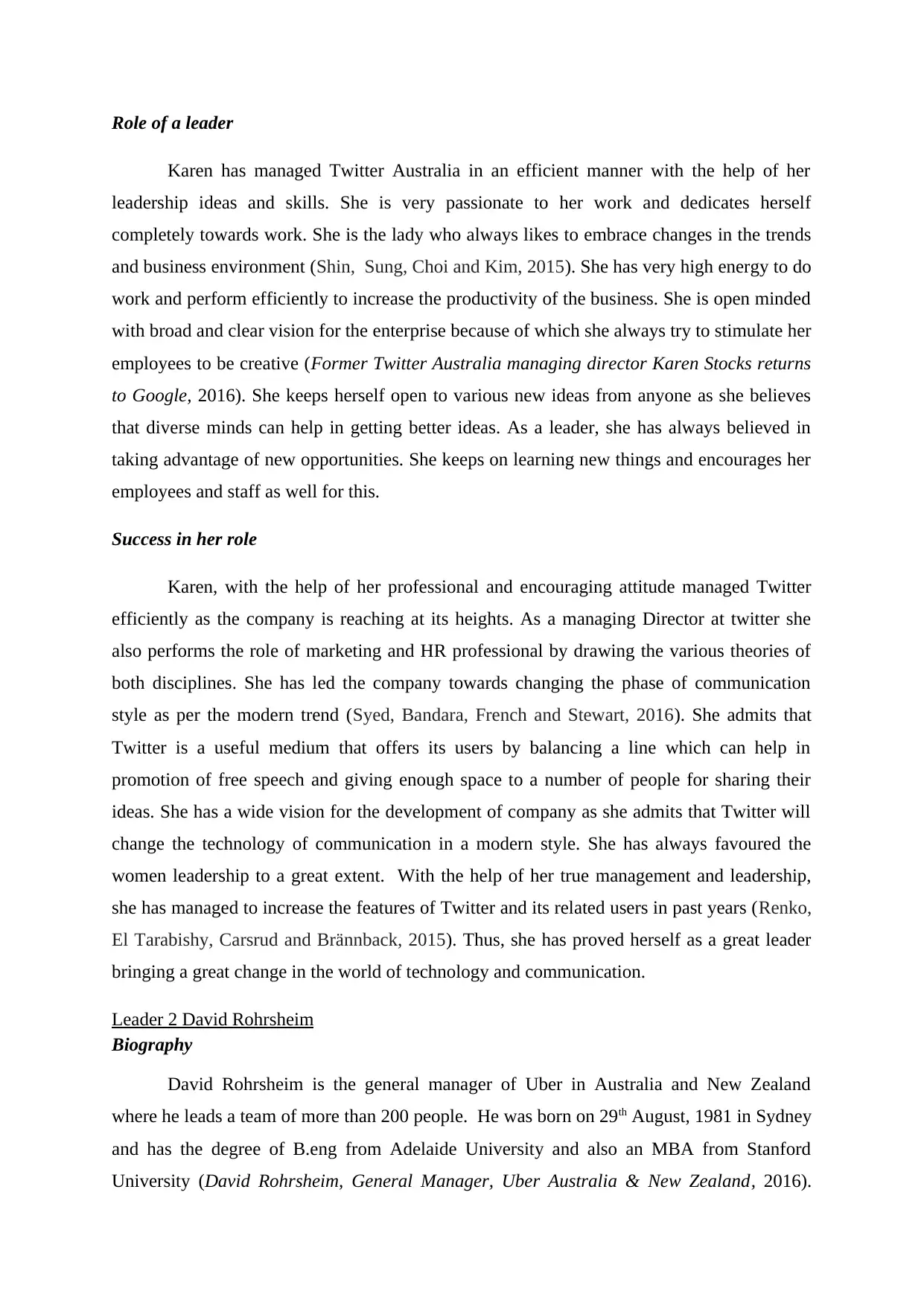
Role of a leader
Karen has managed Twitter Australia in an efficient manner with the help of her
leadership ideas and skills. She is very passionate to her work and dedicates herself
completely towards work. She is the lady who always likes to embrace changes in the trends
and business environment (Shin, Sung, Choi and Kim, 2015). She has very high energy to do
work and perform efficiently to increase the productivity of the business. She is open minded
with broad and clear vision for the enterprise because of which she always try to stimulate her
employees to be creative (Former Twitter Australia managing director Karen Stocks returns
to Google, 2016). She keeps herself open to various new ideas from anyone as she believes
that diverse minds can help in getting better ideas. As a leader, she has always believed in
taking advantage of new opportunities. She keeps on learning new things and encourages her
employees and staff as well for this.
Success in her role
Karen, with the help of her professional and encouraging attitude managed Twitter
efficiently as the company is reaching at its heights. As a managing Director at twitter she
also performs the role of marketing and HR professional by drawing the various theories of
both disciplines. She has led the company towards changing the phase of communication
style as per the modern trend (Syed, Bandara, French and Stewart, 2016). She admits that
Twitter is a useful medium that offers its users by balancing a line which can help in
promotion of free speech and giving enough space to a number of people for sharing their
ideas. She has a wide vision for the development of company as she admits that Twitter will
change the technology of communication in a modern style. She has always favoured the
women leadership to a great extent. With the help of her true management and leadership,
she has managed to increase the features of Twitter and its related users in past years (Renko,
El Tarabishy, Carsrud and Brännback, 2015). Thus, she has proved herself as a great leader
bringing a great change in the world of technology and communication.
Leader 2 David Rohrsheim
Biography
David Rohrsheim is the general manager of Uber in Australia and New Zealand
where he leads a team of more than 200 people. He was born on 29th August, 1981 in Sydney
and has the degree of B.eng from Adelaide University and also an MBA from Stanford
University (David Rohrsheim, General Manager, Uber Australia & New Zealand, 2016).
Karen has managed Twitter Australia in an efficient manner with the help of her
leadership ideas and skills. She is very passionate to her work and dedicates herself
completely towards work. She is the lady who always likes to embrace changes in the trends
and business environment (Shin, Sung, Choi and Kim, 2015). She has very high energy to do
work and perform efficiently to increase the productivity of the business. She is open minded
with broad and clear vision for the enterprise because of which she always try to stimulate her
employees to be creative (Former Twitter Australia managing director Karen Stocks returns
to Google, 2016). She keeps herself open to various new ideas from anyone as she believes
that diverse minds can help in getting better ideas. As a leader, she has always believed in
taking advantage of new opportunities. She keeps on learning new things and encourages her
employees and staff as well for this.
Success in her role
Karen, with the help of her professional and encouraging attitude managed Twitter
efficiently as the company is reaching at its heights. As a managing Director at twitter she
also performs the role of marketing and HR professional by drawing the various theories of
both disciplines. She has led the company towards changing the phase of communication
style as per the modern trend (Syed, Bandara, French and Stewart, 2016). She admits that
Twitter is a useful medium that offers its users by balancing a line which can help in
promotion of free speech and giving enough space to a number of people for sharing their
ideas. She has a wide vision for the development of company as she admits that Twitter will
change the technology of communication in a modern style. She has always favoured the
women leadership to a great extent. With the help of her true management and leadership,
she has managed to increase the features of Twitter and its related users in past years (Renko,
El Tarabishy, Carsrud and Brännback, 2015). Thus, she has proved herself as a great leader
bringing a great change in the world of technology and communication.
Leader 2 David Rohrsheim
Biography
David Rohrsheim is the general manager of Uber in Australia and New Zealand
where he leads a team of more than 200 people. He was born on 29th August, 1981 in Sydney
and has the degree of B.eng from Adelaide University and also an MBA from Stanford
University (David Rohrsheim, General Manager, Uber Australia & New Zealand, 2016).
Secure Best Marks with AI Grader
Need help grading? Try our AI Grader for instant feedback on your assignments.
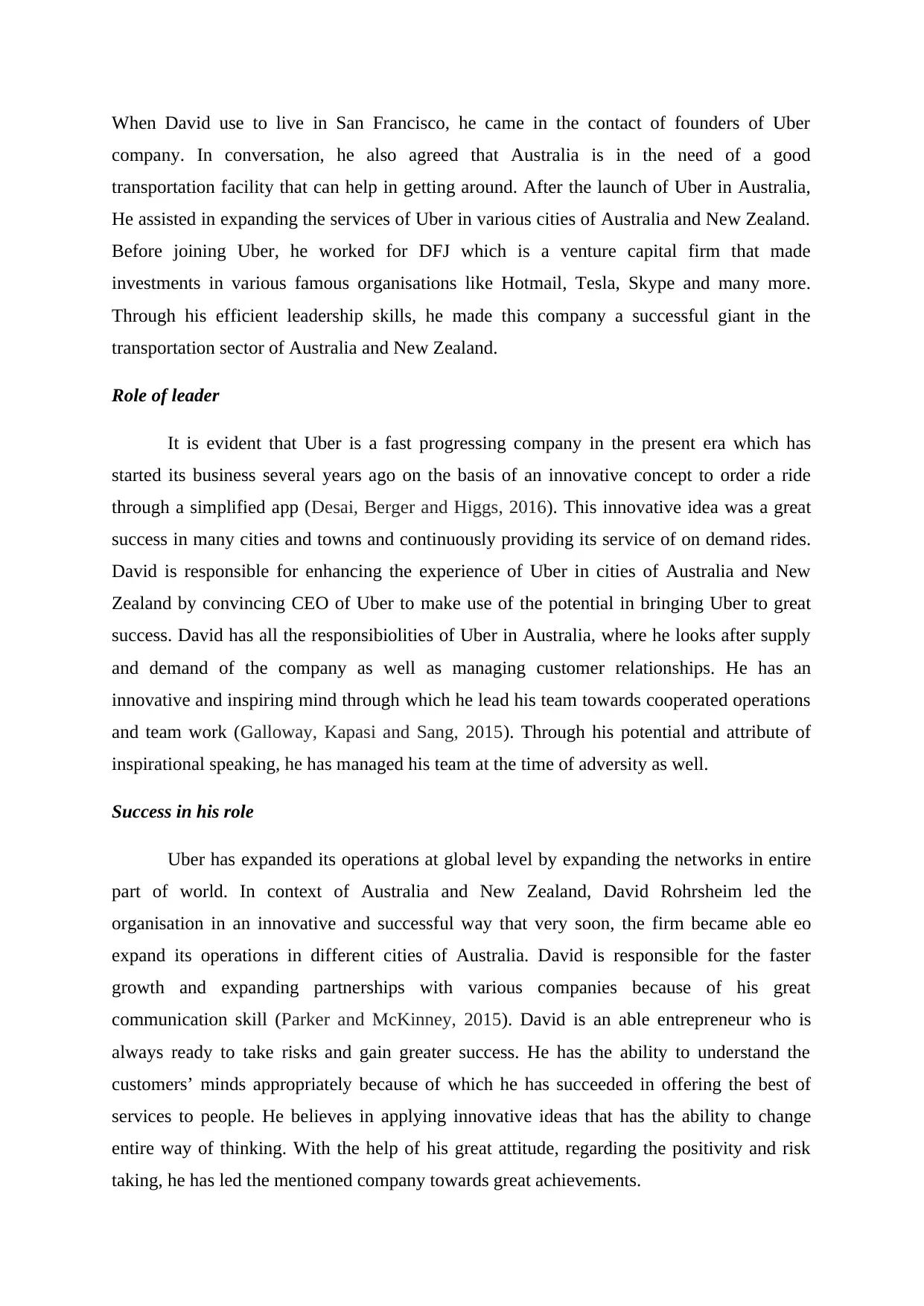
When David use to live in San Francisco, he came in the contact of founders of Uber
company. In conversation, he also agreed that Australia is in the need of a good
transportation facility that can help in getting around. After the launch of Uber in Australia,
He assisted in expanding the services of Uber in various cities of Australia and New Zealand.
Before joining Uber, he worked for DFJ which is a venture capital firm that made
investments in various famous organisations like Hotmail, Tesla, Skype and many more.
Through his efficient leadership skills, he made this company a successful giant in the
transportation sector of Australia and New Zealand.
Role of leader
It is evident that Uber is a fast progressing company in the present era which has
started its business several years ago on the basis of an innovative concept to order a ride
through a simplified app (Desai, Berger and Higgs, 2016). This innovative idea was a great
success in many cities and towns and continuously providing its service of on demand rides.
David is responsible for enhancing the experience of Uber in cities of Australia and New
Zealand by convincing CEO of Uber to make use of the potential in bringing Uber to great
success. David has all the responsibiolities of Uber in Australia, where he looks after supply
and demand of the company as well as managing customer relationships. He has an
innovative and inspiring mind through which he lead his team towards cooperated operations
and team work (Galloway, Kapasi and Sang, 2015). Through his potential and attribute of
inspirational speaking, he has managed his team at the time of adversity as well.
Success in his role
Uber has expanded its operations at global level by expanding the networks in entire
part of world. In context of Australia and New Zealand, David Rohrsheim led the
organisation in an innovative and successful way that very soon, the firm became able eo
expand its operations in different cities of Australia. David is responsible for the faster
growth and expanding partnerships with various companies because of his great
communication skill (Parker and McKinney, 2015). David is an able entrepreneur who is
always ready to take risks and gain greater success. He has the ability to understand the
customers’ minds appropriately because of which he has succeeded in offering the best of
services to people. He believes in applying innovative ideas that has the ability to change
entire way of thinking. With the help of his great attitude, regarding the positivity and risk
taking, he has led the mentioned company towards great achievements.
company. In conversation, he also agreed that Australia is in the need of a good
transportation facility that can help in getting around. After the launch of Uber in Australia,
He assisted in expanding the services of Uber in various cities of Australia and New Zealand.
Before joining Uber, he worked for DFJ which is a venture capital firm that made
investments in various famous organisations like Hotmail, Tesla, Skype and many more.
Through his efficient leadership skills, he made this company a successful giant in the
transportation sector of Australia and New Zealand.
Role of leader
It is evident that Uber is a fast progressing company in the present era which has
started its business several years ago on the basis of an innovative concept to order a ride
through a simplified app (Desai, Berger and Higgs, 2016). This innovative idea was a great
success in many cities and towns and continuously providing its service of on demand rides.
David is responsible for enhancing the experience of Uber in cities of Australia and New
Zealand by convincing CEO of Uber to make use of the potential in bringing Uber to great
success. David has all the responsibiolities of Uber in Australia, where he looks after supply
and demand of the company as well as managing customer relationships. He has an
innovative and inspiring mind through which he lead his team towards cooperated operations
and team work (Galloway, Kapasi and Sang, 2015). Through his potential and attribute of
inspirational speaking, he has managed his team at the time of adversity as well.
Success in his role
Uber has expanded its operations at global level by expanding the networks in entire
part of world. In context of Australia and New Zealand, David Rohrsheim led the
organisation in an innovative and successful way that very soon, the firm became able eo
expand its operations in different cities of Australia. David is responsible for the faster
growth and expanding partnerships with various companies because of his great
communication skill (Parker and McKinney, 2015). David is an able entrepreneur who is
always ready to take risks and gain greater success. He has the ability to understand the
customers’ minds appropriately because of which he has succeeded in offering the best of
services to people. He believes in applying innovative ideas that has the ability to change
entire way of thinking. With the help of his great attitude, regarding the positivity and risk
taking, he has led the mentioned company towards great achievements.
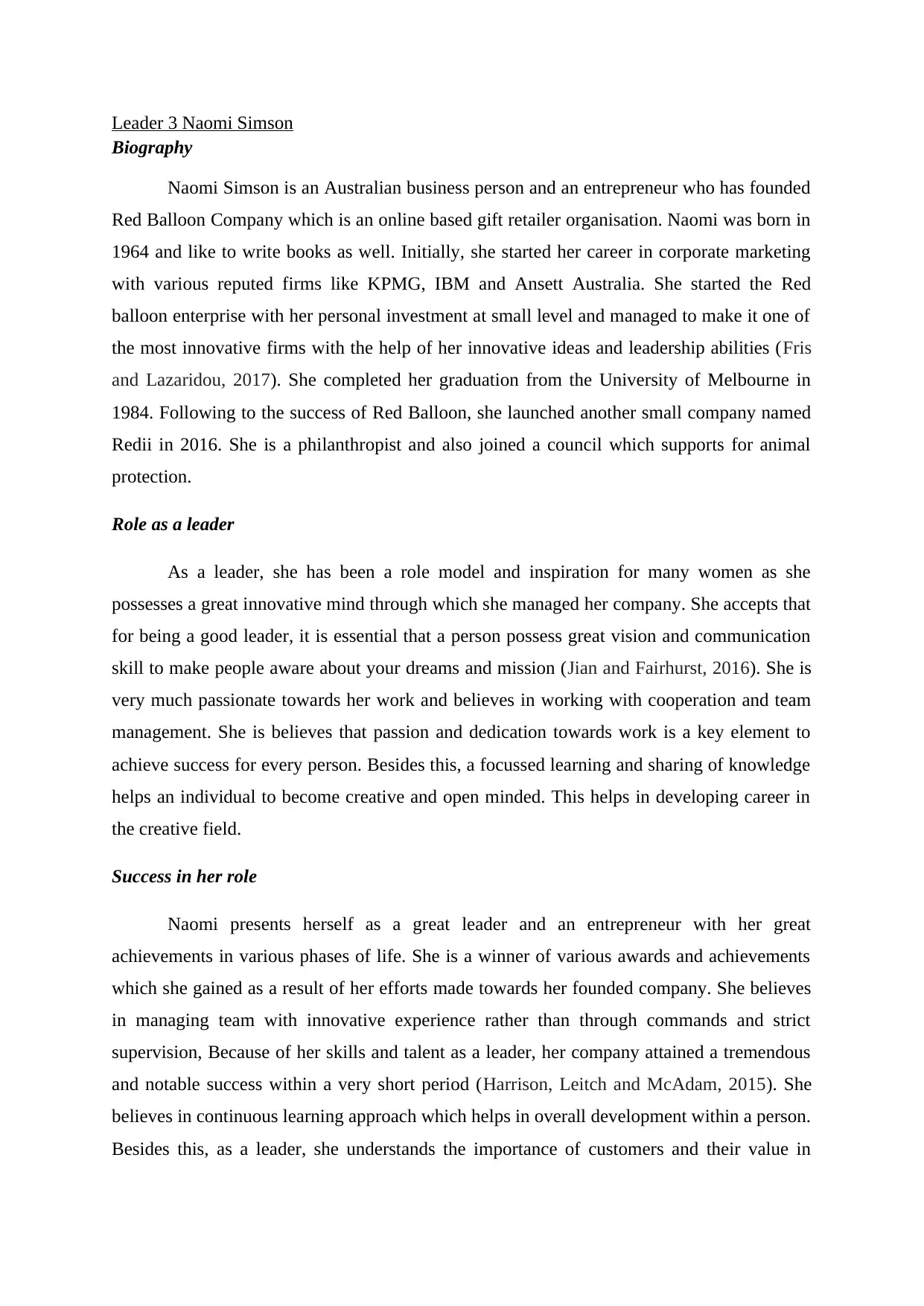
Leader 3 Naomi Simson
Biography
Naomi Simson is an Australian business person and an entrepreneur who has founded
Red Balloon Company which is an online based gift retailer organisation. Naomi was born in
1964 and like to write books as well. Initially, she started her career in corporate marketing
with various reputed firms like KPMG, IBM and Ansett Australia. She started the Red
balloon enterprise with her personal investment at small level and managed to make it one of
the most innovative firms with the help of her innovative ideas and leadership abilities (Fris
and Lazaridou, 2017). She completed her graduation from the University of Melbourne in
1984. Following to the success of Red Balloon, she launched another small company named
Redii in 2016. She is a philanthropist and also joined a council which supports for animal
protection.
Role as a leader
As a leader, she has been a role model and inspiration for many women as she
possesses a great innovative mind through which she managed her company. She accepts that
for being a good leader, it is essential that a person possess great vision and communication
skill to make people aware about your dreams and mission (Jian and Fairhurst, 2016). She is
very much passionate towards her work and believes in working with cooperation and team
management. She is believes that passion and dedication towards work is a key element to
achieve success for every person. Besides this, a focussed learning and sharing of knowledge
helps an individual to become creative and open minded. This helps in developing career in
the creative field.
Success in her role
Naomi presents herself as a great leader and an entrepreneur with her great
achievements in various phases of life. She is a winner of various awards and achievements
which she gained as a result of her efforts made towards her founded company. She believes
in managing team with innovative experience rather than through commands and strict
supervision, Because of her skills and talent as a leader, her company attained a tremendous
and notable success within a very short period (Harrison, Leitch and McAdam, 2015). She
believes in continuous learning approach which helps in overall development within a person.
Besides this, as a leader, she understands the importance of customers and their value in
Biography
Naomi Simson is an Australian business person and an entrepreneur who has founded
Red Balloon Company which is an online based gift retailer organisation. Naomi was born in
1964 and like to write books as well. Initially, she started her career in corporate marketing
with various reputed firms like KPMG, IBM and Ansett Australia. She started the Red
balloon enterprise with her personal investment at small level and managed to make it one of
the most innovative firms with the help of her innovative ideas and leadership abilities (Fris
and Lazaridou, 2017). She completed her graduation from the University of Melbourne in
1984. Following to the success of Red Balloon, she launched another small company named
Redii in 2016. She is a philanthropist and also joined a council which supports for animal
protection.
Role as a leader
As a leader, she has been a role model and inspiration for many women as she
possesses a great innovative mind through which she managed her company. She accepts that
for being a good leader, it is essential that a person possess great vision and communication
skill to make people aware about your dreams and mission (Jian and Fairhurst, 2016). She is
very much passionate towards her work and believes in working with cooperation and team
management. She is believes that passion and dedication towards work is a key element to
achieve success for every person. Besides this, a focussed learning and sharing of knowledge
helps an individual to become creative and open minded. This helps in developing career in
the creative field.
Success in her role
Naomi presents herself as a great leader and an entrepreneur with her great
achievements in various phases of life. She is a winner of various awards and achievements
which she gained as a result of her efforts made towards her founded company. She believes
in managing team with innovative experience rather than through commands and strict
supervision, Because of her skills and talent as a leader, her company attained a tremendous
and notable success within a very short period (Harrison, Leitch and McAdam, 2015). She
believes in continuous learning approach which helps in overall development within a person.
Besides this, as a leader, she understands the importance of customers and their value in
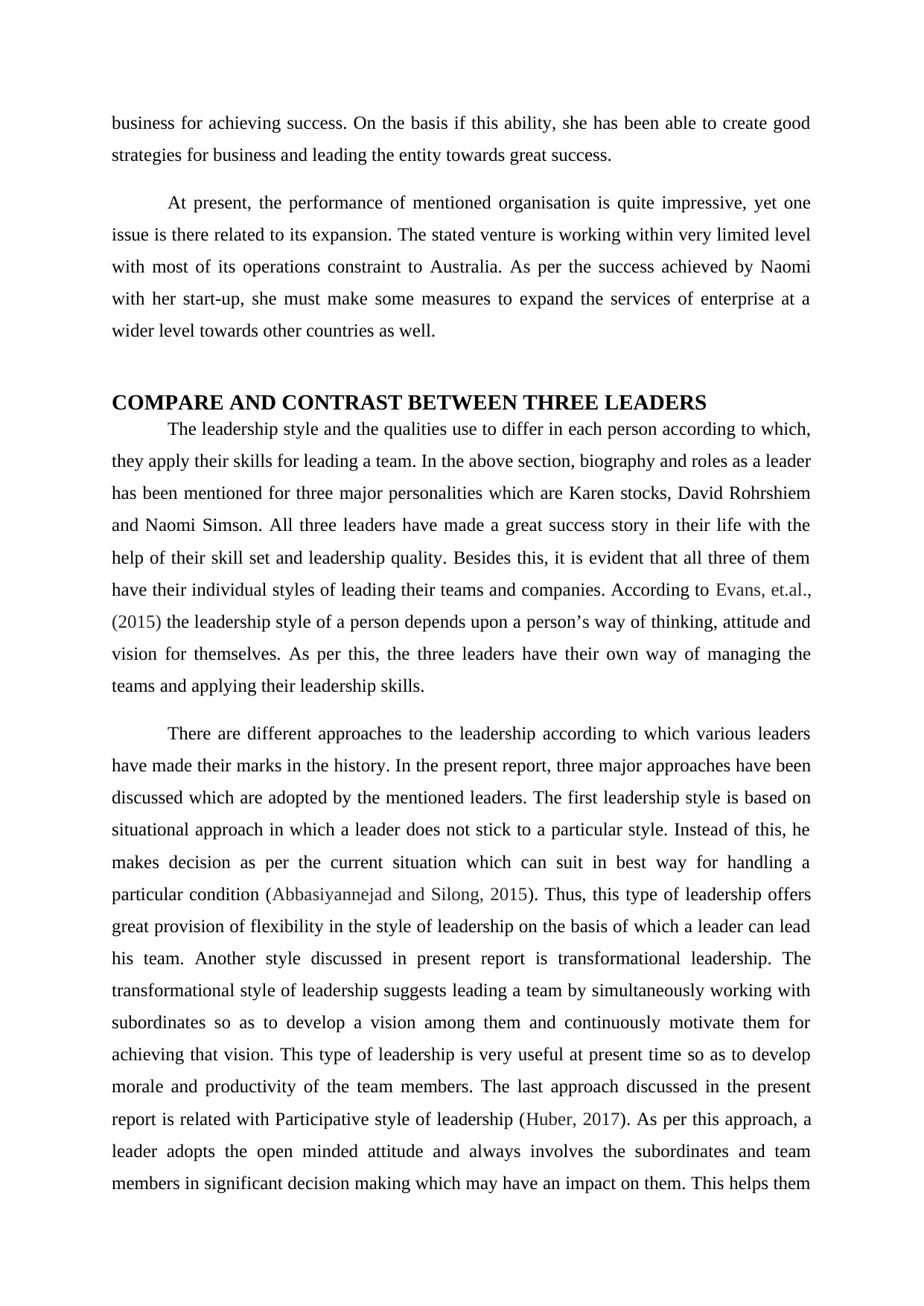
business for achieving success. On the basis if this ability, she has been able to create good
strategies for business and leading the entity towards great success.
At present, the performance of mentioned organisation is quite impressive, yet one
issue is there related to its expansion. The stated venture is working within very limited level
with most of its operations constraint to Australia. As per the success achieved by Naomi
with her start-up, she must make some measures to expand the services of enterprise at a
wider level towards other countries as well.
COMPARE AND CONTRAST BETWEEN THREE LEADERS
The leadership style and the qualities use to differ in each person according to which,
they apply their skills for leading a team. In the above section, biography and roles as a leader
has been mentioned for three major personalities which are Karen stocks, David Rohrshiem
and Naomi Simson. All three leaders have made a great success story in their life with the
help of their skill set and leadership quality. Besides this, it is evident that all three of them
have their individual styles of leading their teams and companies. According to Evans, et.al.,
(2015) the leadership style of a person depends upon a person’s way of thinking, attitude and
vision for themselves. As per this, the three leaders have their own way of managing the
teams and applying their leadership skills.
There are different approaches to the leadership according to which various leaders
have made their marks in the history. In the present report, three major approaches have been
discussed which are adopted by the mentioned leaders. The first leadership style is based on
situational approach in which a leader does not stick to a particular style. Instead of this, he
makes decision as per the current situation which can suit in best way for handling a
particular condition (Abbasiyannejad and Silong, 2015). Thus, this type of leadership offers
great provision of flexibility in the style of leadership on the basis of which a leader can lead
his team. Another style discussed in present report is transformational leadership. The
transformational style of leadership suggests leading a team by simultaneously working with
subordinates so as to develop a vision among them and continuously motivate them for
achieving that vision. This type of leadership is very useful at present time so as to develop
morale and productivity of the team members. The last approach discussed in the present
report is related with Participative style of leadership (Huber, 2017). As per this approach, a
leader adopts the open minded attitude and always involves the subordinates and team
members in significant decision making which may have an impact on them. This helps them
strategies for business and leading the entity towards great success.
At present, the performance of mentioned organisation is quite impressive, yet one
issue is there related to its expansion. The stated venture is working within very limited level
with most of its operations constraint to Australia. As per the success achieved by Naomi
with her start-up, she must make some measures to expand the services of enterprise at a
wider level towards other countries as well.
COMPARE AND CONTRAST BETWEEN THREE LEADERS
The leadership style and the qualities use to differ in each person according to which,
they apply their skills for leading a team. In the above section, biography and roles as a leader
has been mentioned for three major personalities which are Karen stocks, David Rohrshiem
and Naomi Simson. All three leaders have made a great success story in their life with the
help of their skill set and leadership quality. Besides this, it is evident that all three of them
have their individual styles of leading their teams and companies. According to Evans, et.al.,
(2015) the leadership style of a person depends upon a person’s way of thinking, attitude and
vision for themselves. As per this, the three leaders have their own way of managing the
teams and applying their leadership skills.
There are different approaches to the leadership according to which various leaders
have made their marks in the history. In the present report, three major approaches have been
discussed which are adopted by the mentioned leaders. The first leadership style is based on
situational approach in which a leader does not stick to a particular style. Instead of this, he
makes decision as per the current situation which can suit in best way for handling a
particular condition (Abbasiyannejad and Silong, 2015). Thus, this type of leadership offers
great provision of flexibility in the style of leadership on the basis of which a leader can lead
his team. Another style discussed in present report is transformational leadership. The
transformational style of leadership suggests leading a team by simultaneously working with
subordinates so as to develop a vision among them and continuously motivate them for
achieving that vision. This type of leadership is very useful at present time so as to develop
morale and productivity of the team members. The last approach discussed in the present
report is related with Participative style of leadership (Huber, 2017). As per this approach, a
leader adopts the open minded attitude and always involves the subordinates and team
members in significant decision making which may have an impact on them. This helps them
Paraphrase This Document
Need a fresh take? Get an instant paraphrase of this document with our AI Paraphraser

in facing less number of oppositions towards change and towards a particular decision.
Besides this, it motivates the team members and aids in realising them their importance
within enterprise. Thus, all three approaches have their own merits or advantages for the
organisation.
As per the present study and current business environment, the significance of
Situational leadership is immense Smyth, (2016) state that the Situational leadership gives
enough of flexibility regarding decision making and leading approaches. The situational
leadership style is based on making decisions as per the situations so that a correct decision
can be made over a specific condition. As per this, a leader has the enough flexibility to
change his ideas and decisions without sticking to a particular thought. In case of present
study, David Rohrsheim favours this situational leadership approach for leading his business
organisation. The current environment of transportation sector is highly dynamic and full of
competitions. In such situations, it is essential that the companies take relevant decisions as
per the current condition (De Vita and Case, 2016). In addition to this, he makes decisions on
the basis of his intellectual skills and applies his potential to manipulate the adverse
circumstances into positive opportunities.
Aizikovitsh-Udi and Cheng, (2015) argue that participative leadership style is a key to
develop a business organisation into a successful venture. As per this approach, Naomi
Simson is the supporter of this leadership style. She uses to involve her small team into every
phase of decision making so as to welcome diverse minds in finding a solution to a specific
problem. Besides this, she likes to increase the team cooperation with the help of group
efforts for each kind of small to big works which is a key to transform the way of working.
On other hand, Karen Stocks basically adopts the transformational leadership style for
leading her organisation (Ghanizadeh, 2017). She develops the broad vision for her enterprise
and works simultaneously with her subordinates to lead the required change within
enterprise. Further, she guides the changes within her entity by inspiring her followers to
become adaptive in nature so as to change themselves as per the situations. Thus, all three
leaders use to follow their individual styles of leadership for guiding the behaviour of their
team.
As per Shek, Sun and Liu, (2015) different styles of leadership makes a difference
between various leaders as it guides the behaviour and attitude of an individual. David
Rohrshiem has a strong leadership attitude and use to lead his team accordingly. He believes
Besides this, it motivates the team members and aids in realising them their importance
within enterprise. Thus, all three approaches have their own merits or advantages for the
organisation.
As per the present study and current business environment, the significance of
Situational leadership is immense Smyth, (2016) state that the Situational leadership gives
enough of flexibility regarding decision making and leading approaches. The situational
leadership style is based on making decisions as per the situations so that a correct decision
can be made over a specific condition. As per this, a leader has the enough flexibility to
change his ideas and decisions without sticking to a particular thought. In case of present
study, David Rohrsheim favours this situational leadership approach for leading his business
organisation. The current environment of transportation sector is highly dynamic and full of
competitions. In such situations, it is essential that the companies take relevant decisions as
per the current condition (De Vita and Case, 2016). In addition to this, he makes decisions on
the basis of his intellectual skills and applies his potential to manipulate the adverse
circumstances into positive opportunities.
Aizikovitsh-Udi and Cheng, (2015) argue that participative leadership style is a key to
develop a business organisation into a successful venture. As per this approach, Naomi
Simson is the supporter of this leadership style. She uses to involve her small team into every
phase of decision making so as to welcome diverse minds in finding a solution to a specific
problem. Besides this, she likes to increase the team cooperation with the help of group
efforts for each kind of small to big works which is a key to transform the way of working.
On other hand, Karen Stocks basically adopts the transformational leadership style for
leading her organisation (Ghanizadeh, 2017). She develops the broad vision for her enterprise
and works simultaneously with her subordinates to lead the required change within
enterprise. Further, she guides the changes within her entity by inspiring her followers to
become adaptive in nature so as to change themselves as per the situations. Thus, all three
leaders use to follow their individual styles of leadership for guiding the behaviour of their
team.
As per Shek, Sun and Liu, (2015) different styles of leadership makes a difference
between various leaders as it guides the behaviour and attitude of an individual. David
Rohrshiem has a strong leadership attitude and use to lead his team accordingly. He believes
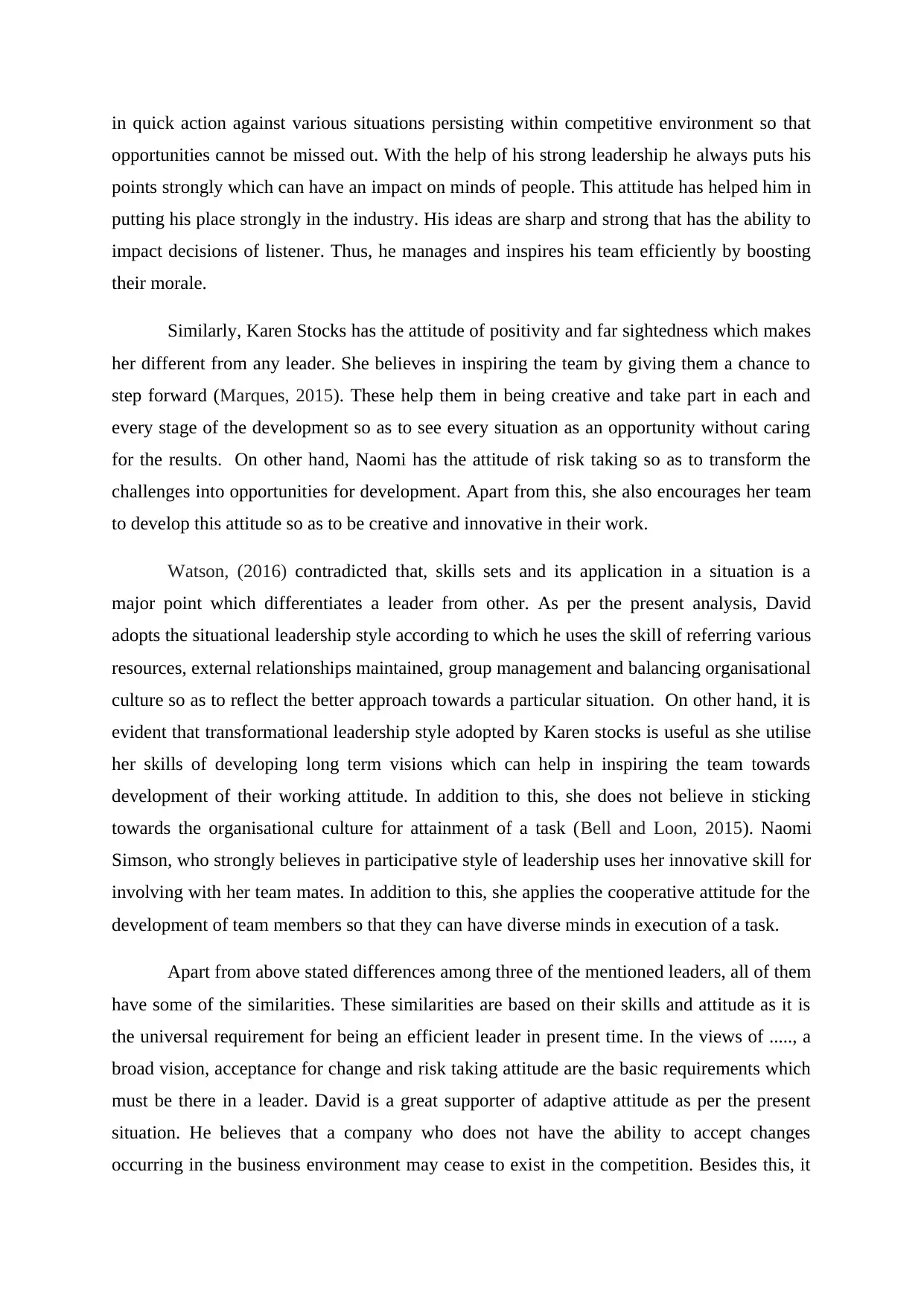
in quick action against various situations persisting within competitive environment so that
opportunities cannot be missed out. With the help of his strong leadership he always puts his
points strongly which can have an impact on minds of people. This attitude has helped him in
putting his place strongly in the industry. His ideas are sharp and strong that has the ability to
impact decisions of listener. Thus, he manages and inspires his team efficiently by boosting
their morale.
Similarly, Karen Stocks has the attitude of positivity and far sightedness which makes
her different from any leader. She believes in inspiring the team by giving them a chance to
step forward (Marques, 2015). These help them in being creative and take part in each and
every stage of the development so as to see every situation as an opportunity without caring
for the results. On other hand, Naomi has the attitude of risk taking so as to transform the
challenges into opportunities for development. Apart from this, she also encourages her team
to develop this attitude so as to be creative and innovative in their work.
Watson, (2016) contradicted that, skills sets and its application in a situation is a
major point which differentiates a leader from other. As per the present analysis, David
adopts the situational leadership style according to which he uses the skill of referring various
resources, external relationships maintained, group management and balancing organisational
culture so as to reflect the better approach towards a particular situation. On other hand, it is
evident that transformational leadership style adopted by Karen stocks is useful as she utilise
her skills of developing long term visions which can help in inspiring the team towards
development of their working attitude. In addition to this, she does not believe in sticking
towards the organisational culture for attainment of a task (Bell and Loon, 2015). Naomi
Simson, who strongly believes in participative style of leadership uses her innovative skill for
involving with her team mates. In addition to this, she applies the cooperative attitude for the
development of team members so that they can have diverse minds in execution of a task.
Apart from above stated differences among three of the mentioned leaders, all of them
have some of the similarities. These similarities are based on their skills and attitude as it is
the universal requirement for being an efficient leader in present time. In the views of ....., a
broad vision, acceptance for change and risk taking attitude are the basic requirements which
must be there in a leader. David is a great supporter of adaptive attitude as per the present
situation. He believes that a company who does not have the ability to accept changes
occurring in the business environment may cease to exist in the competition. Besides this, it
opportunities cannot be missed out. With the help of his strong leadership he always puts his
points strongly which can have an impact on minds of people. This attitude has helped him in
putting his place strongly in the industry. His ideas are sharp and strong that has the ability to
impact decisions of listener. Thus, he manages and inspires his team efficiently by boosting
their morale.
Similarly, Karen Stocks has the attitude of positivity and far sightedness which makes
her different from any leader. She believes in inspiring the team by giving them a chance to
step forward (Marques, 2015). These help them in being creative and take part in each and
every stage of the development so as to see every situation as an opportunity without caring
for the results. On other hand, Naomi has the attitude of risk taking so as to transform the
challenges into opportunities for development. Apart from this, she also encourages her team
to develop this attitude so as to be creative and innovative in their work.
Watson, (2016) contradicted that, skills sets and its application in a situation is a
major point which differentiates a leader from other. As per the present analysis, David
adopts the situational leadership style according to which he uses the skill of referring various
resources, external relationships maintained, group management and balancing organisational
culture so as to reflect the better approach towards a particular situation. On other hand, it is
evident that transformational leadership style adopted by Karen stocks is useful as she utilise
her skills of developing long term visions which can help in inspiring the team towards
development of their working attitude. In addition to this, she does not believe in sticking
towards the organisational culture for attainment of a task (Bell and Loon, 2015). Naomi
Simson, who strongly believes in participative style of leadership uses her innovative skill for
involving with her team mates. In addition to this, she applies the cooperative attitude for the
development of team members so that they can have diverse minds in execution of a task.
Apart from above stated differences among three of the mentioned leaders, all of them
have some of the similarities. These similarities are based on their skills and attitude as it is
the universal requirement for being an efficient leader in present time. In the views of ....., a
broad vision, acceptance for change and risk taking attitude are the basic requirements which
must be there in a leader. David is a great supporter of adaptive attitude as per the present
situation. He believes that a company who does not have the ability to accept changes
occurring in the business environment may cease to exist in the competition. Besides this, it
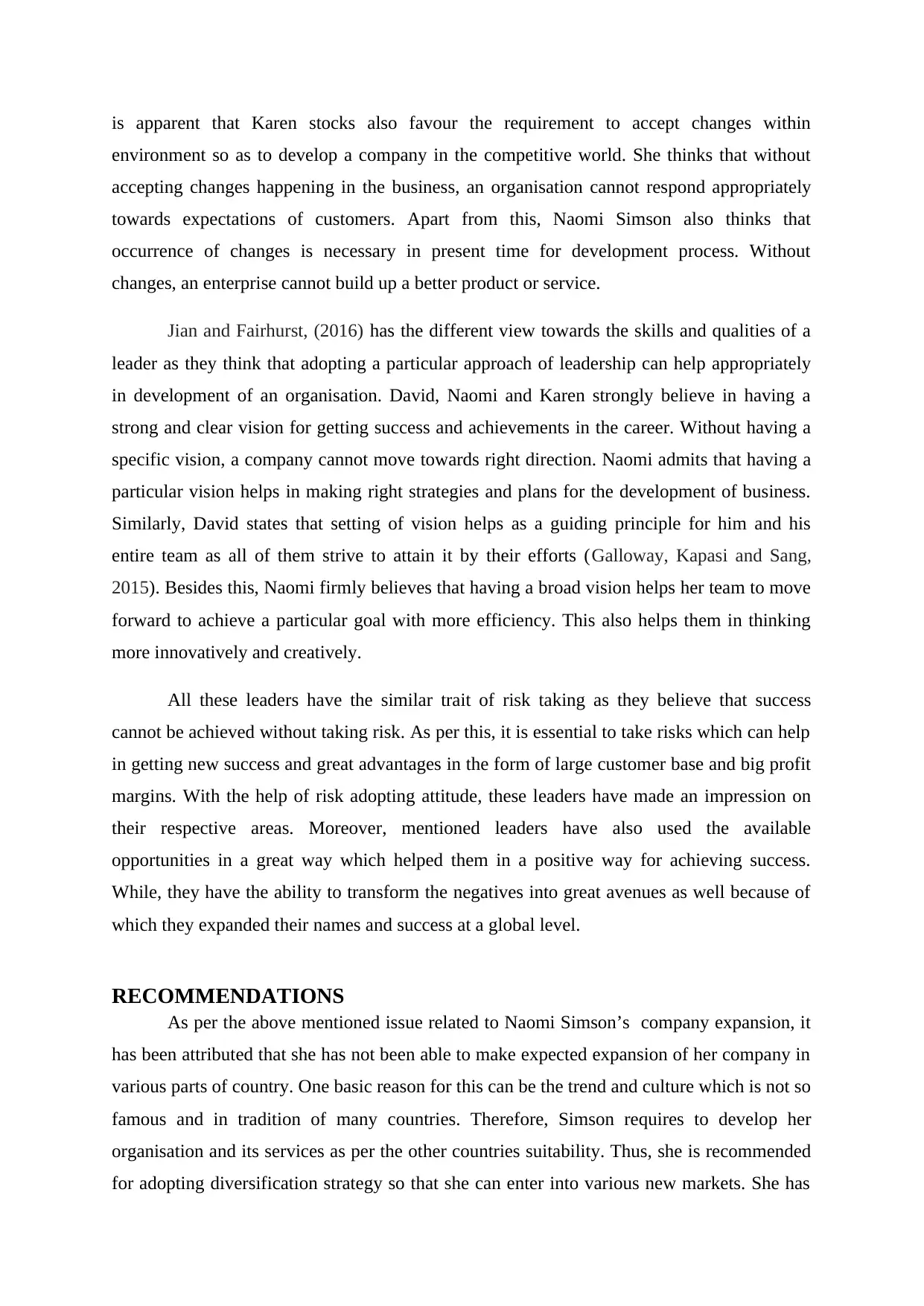
is apparent that Karen stocks also favour the requirement to accept changes within
environment so as to develop a company in the competitive world. She thinks that without
accepting changes happening in the business, an organisation cannot respond appropriately
towards expectations of customers. Apart from this, Naomi Simson also thinks that
occurrence of changes is necessary in present time for development process. Without
changes, an enterprise cannot build up a better product or service.
Jian and Fairhurst, (2016) has the different view towards the skills and qualities of a
leader as they think that adopting a particular approach of leadership can help appropriately
in development of an organisation. David, Naomi and Karen strongly believe in having a
strong and clear vision for getting success and achievements in the career. Without having a
specific vision, a company cannot move towards right direction. Naomi admits that having a
particular vision helps in making right strategies and plans for the development of business.
Similarly, David states that setting of vision helps as a guiding principle for him and his
entire team as all of them strive to attain it by their efforts (Galloway, Kapasi and Sang,
2015). Besides this, Naomi firmly believes that having a broad vision helps her team to move
forward to achieve a particular goal with more efficiency. This also helps them in thinking
more innovatively and creatively.
All these leaders have the similar trait of risk taking as they believe that success
cannot be achieved without taking risk. As per this, it is essential to take risks which can help
in getting new success and great advantages in the form of large customer base and big profit
margins. With the help of risk adopting attitude, these leaders have made an impression on
their respective areas. Moreover, mentioned leaders have also used the available
opportunities in a great way which helped them in a positive way for achieving success.
While, they have the ability to transform the negatives into great avenues as well because of
which they expanded their names and success at a global level.
RECOMMENDATIONS
As per the above mentioned issue related to Naomi Simson’s company expansion, it
has been attributed that she has not been able to make expected expansion of her company in
various parts of country. One basic reason for this can be the trend and culture which is not so
famous and in tradition of many countries. Therefore, Simson requires to develop her
organisation and its services as per the other countries suitability. Thus, she is recommended
for adopting diversification strategy so that she can enter into various new markets. She has
environment so as to develop a company in the competitive world. She thinks that without
accepting changes happening in the business, an organisation cannot respond appropriately
towards expectations of customers. Apart from this, Naomi Simson also thinks that
occurrence of changes is necessary in present time for development process. Without
changes, an enterprise cannot build up a better product or service.
Jian and Fairhurst, (2016) has the different view towards the skills and qualities of a
leader as they think that adopting a particular approach of leadership can help appropriately
in development of an organisation. David, Naomi and Karen strongly believe in having a
strong and clear vision for getting success and achievements in the career. Without having a
specific vision, a company cannot move towards right direction. Naomi admits that having a
particular vision helps in making right strategies and plans for the development of business.
Similarly, David states that setting of vision helps as a guiding principle for him and his
entire team as all of them strive to attain it by their efforts (Galloway, Kapasi and Sang,
2015). Besides this, Naomi firmly believes that having a broad vision helps her team to move
forward to achieve a particular goal with more efficiency. This also helps them in thinking
more innovatively and creatively.
All these leaders have the similar trait of risk taking as they believe that success
cannot be achieved without taking risk. As per this, it is essential to take risks which can help
in getting new success and great advantages in the form of large customer base and big profit
margins. With the help of risk adopting attitude, these leaders have made an impression on
their respective areas. Moreover, mentioned leaders have also used the available
opportunities in a great way which helped them in a positive way for achieving success.
While, they have the ability to transform the negatives into great avenues as well because of
which they expanded their names and success at a global level.
RECOMMENDATIONS
As per the above mentioned issue related to Naomi Simson’s company expansion, it
has been attributed that she has not been able to make expected expansion of her company in
various parts of country. One basic reason for this can be the trend and culture which is not so
famous and in tradition of many countries. Therefore, Simson requires to develop her
organisation and its services as per the other countries suitability. Thus, she is recommended
for adopting diversification strategy so that she can enter into various new markets. She has
Secure Best Marks with AI Grader
Need help grading? Try our AI Grader for instant feedback on your assignments.
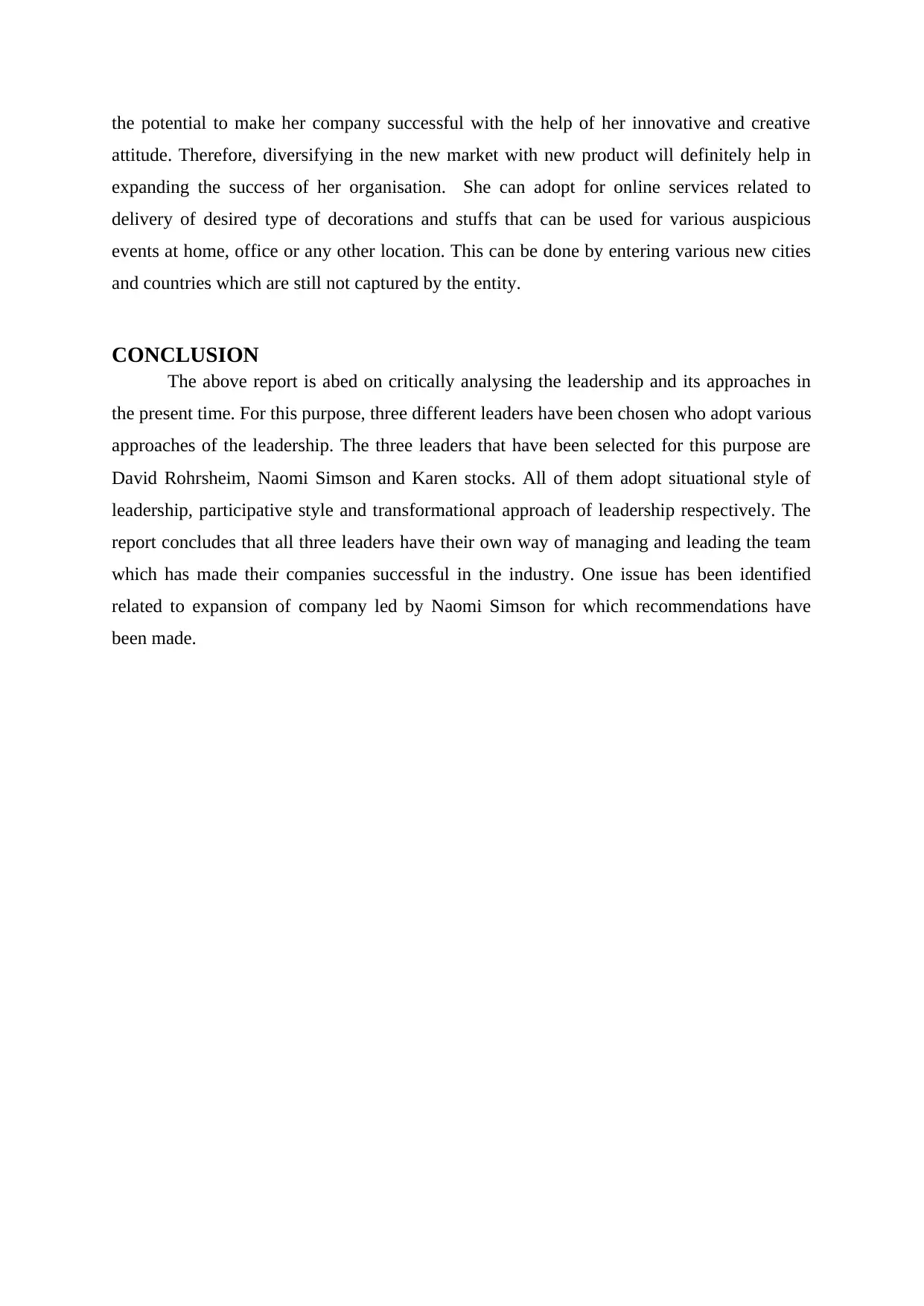
the potential to make her company successful with the help of her innovative and creative
attitude. Therefore, diversifying in the new market with new product will definitely help in
expanding the success of her organisation. She can adopt for online services related to
delivery of desired type of decorations and stuffs that can be used for various auspicious
events at home, office or any other location. This can be done by entering various new cities
and countries which are still not captured by the entity.
CONCLUSION
The above report is abed on critically analysing the leadership and its approaches in
the present time. For this purpose, three different leaders have been chosen who adopt various
approaches of the leadership. The three leaders that have been selected for this purpose are
David Rohrsheim, Naomi Simson and Karen stocks. All of them adopt situational style of
leadership, participative style and transformational approach of leadership respectively. The
report concludes that all three leaders have their own way of managing and leading the team
which has made their companies successful in the industry. One issue has been identified
related to expansion of company led by Naomi Simson for which recommendations have
been made.
attitude. Therefore, diversifying in the new market with new product will definitely help in
expanding the success of her organisation. She can adopt for online services related to
delivery of desired type of decorations and stuffs that can be used for various auspicious
events at home, office or any other location. This can be done by entering various new cities
and countries which are still not captured by the entity.
CONCLUSION
The above report is abed on critically analysing the leadership and its approaches in
the present time. For this purpose, three different leaders have been chosen who adopt various
approaches of the leadership. The three leaders that have been selected for this purpose are
David Rohrsheim, Naomi Simson and Karen stocks. All of them adopt situational style of
leadership, participative style and transformational approach of leadership respectively. The
report concludes that all three leaders have their own way of managing and leading the team
which has made their companies successful in the industry. One issue has been identified
related to expansion of company led by Naomi Simson for which recommendations have
been made.
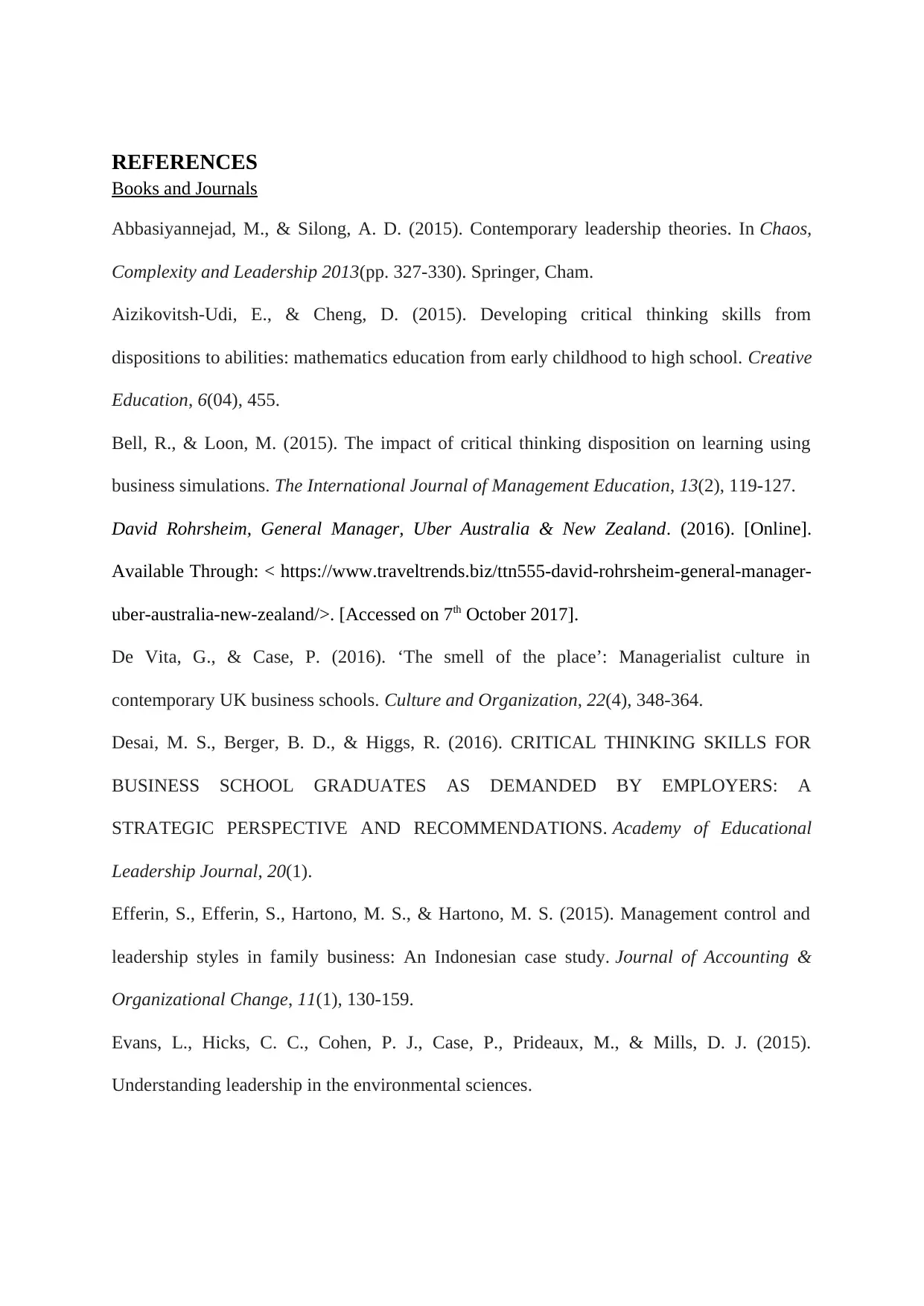
REFERENCES
Books and Journals
Abbasiyannejad, M., & Silong, A. D. (2015). Contemporary leadership theories. In Chaos,
Complexity and Leadership 2013(pp. 327-330). Springer, Cham.
Aizikovitsh-Udi, E., & Cheng, D. (2015). Developing critical thinking skills from
dispositions to abilities: mathematics education from early childhood to high school. Creative
Education, 6(04), 455.
Bell, R., & Loon, M. (2015). The impact of critical thinking disposition on learning using
business simulations. The International Journal of Management Education, 13(2), 119-127.
David Rohrsheim, General Manager, Uber Australia & New Zealand. (2016). [Online].
Available Through: < https://www.traveltrends.biz/ttn555-david-rohrsheim-general-manager-
uber-australia-new-zealand/>. [Accessed on 7th October 2017].
De Vita, G., & Case, P. (2016). ‘The smell of the place’: Managerialist culture in
contemporary UK business schools. Culture and Organization, 22(4), 348-364.
Desai, M. S., Berger, B. D., & Higgs, R. (2016). CRITICAL THINKING SKILLS FOR
BUSINESS SCHOOL GRADUATES AS DEMANDED BY EMPLOYERS: A
STRATEGIC PERSPECTIVE AND RECOMMENDATIONS. Academy of Educational
Leadership Journal, 20(1).
Efferin, S., Efferin, S., Hartono, M. S., & Hartono, M. S. (2015). Management control and
leadership styles in family business: An Indonesian case study. Journal of Accounting &
Organizational Change, 11(1), 130-159.
Evans, L., Hicks, C. C., Cohen, P. J., Case, P., Prideaux, M., & Mills, D. J. (2015).
Understanding leadership in the environmental sciences.
Books and Journals
Abbasiyannejad, M., & Silong, A. D. (2015). Contemporary leadership theories. In Chaos,
Complexity and Leadership 2013(pp. 327-330). Springer, Cham.
Aizikovitsh-Udi, E., & Cheng, D. (2015). Developing critical thinking skills from
dispositions to abilities: mathematics education from early childhood to high school. Creative
Education, 6(04), 455.
Bell, R., & Loon, M. (2015). The impact of critical thinking disposition on learning using
business simulations. The International Journal of Management Education, 13(2), 119-127.
David Rohrsheim, General Manager, Uber Australia & New Zealand. (2016). [Online].
Available Through: < https://www.traveltrends.biz/ttn555-david-rohrsheim-general-manager-
uber-australia-new-zealand/>. [Accessed on 7th October 2017].
De Vita, G., & Case, P. (2016). ‘The smell of the place’: Managerialist culture in
contemporary UK business schools. Culture and Organization, 22(4), 348-364.
Desai, M. S., Berger, B. D., & Higgs, R. (2016). CRITICAL THINKING SKILLS FOR
BUSINESS SCHOOL GRADUATES AS DEMANDED BY EMPLOYERS: A
STRATEGIC PERSPECTIVE AND RECOMMENDATIONS. Academy of Educational
Leadership Journal, 20(1).
Efferin, S., Efferin, S., Hartono, M. S., & Hartono, M. S. (2015). Management control and
leadership styles in family business: An Indonesian case study. Journal of Accounting &
Organizational Change, 11(1), 130-159.
Evans, L., Hicks, C. C., Cohen, P. J., Case, P., Prideaux, M., & Mills, D. J. (2015).
Understanding leadership in the environmental sciences.
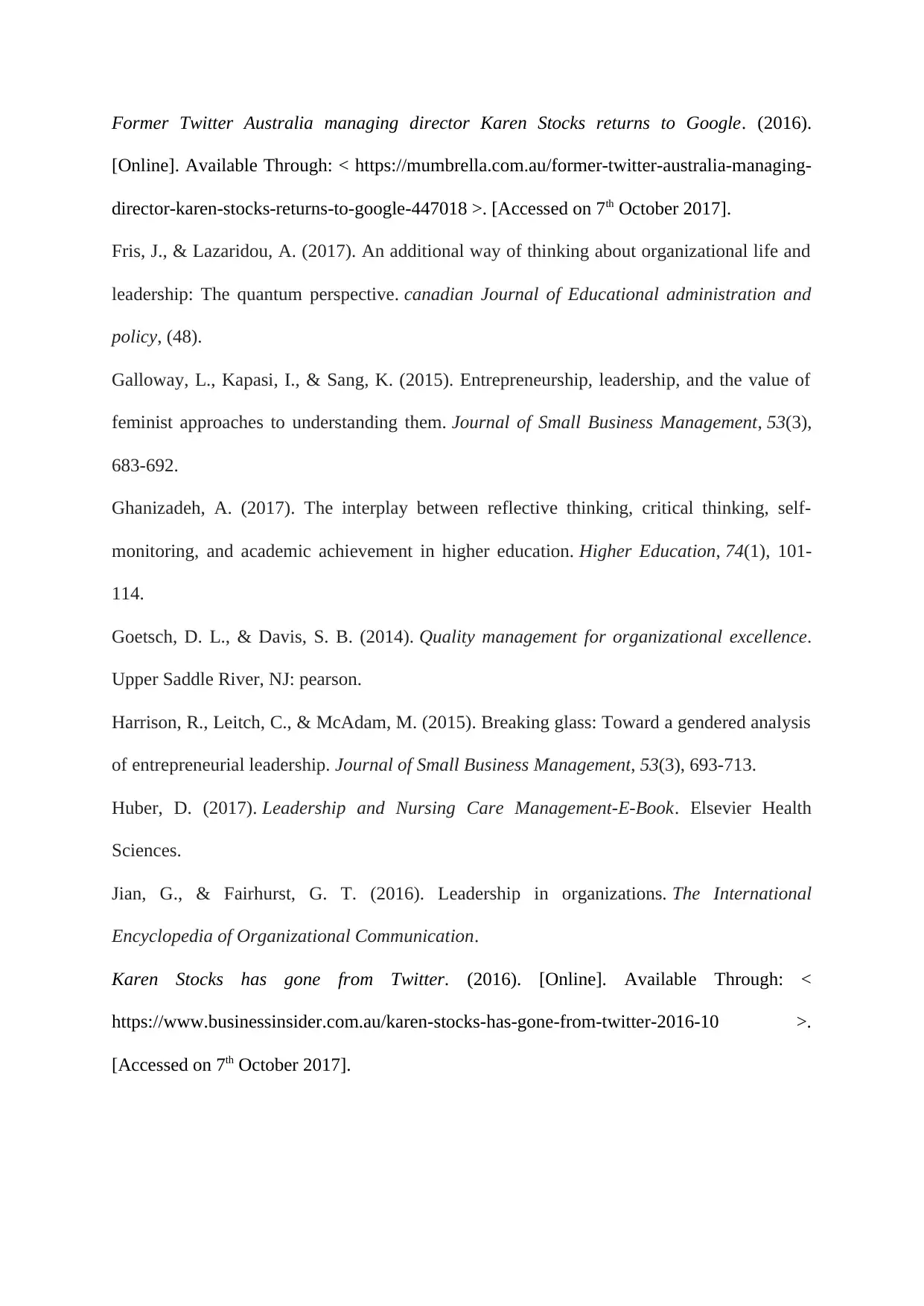
Former Twitter Australia managing director Karen Stocks returns to Google. (2016).
[Online]. Available Through: < https://mumbrella.com.au/former-twitter-australia-managing-
director-karen-stocks-returns-to-google-447018 >. [Accessed on 7th October 2017].
Fris, J., & Lazaridou, A. (2017). An additional way of thinking about organizational life and
leadership: The quantum perspective. canadian Journal of Educational administration and
policy, (48).
Galloway, L., Kapasi, I., & Sang, K. (2015). Entrepreneurship, leadership, and the value of
feminist approaches to understanding them. Journal of Small Business Management, 53(3),
683-692.
Ghanizadeh, A. (2017). The interplay between reflective thinking, critical thinking, self-
monitoring, and academic achievement in higher education. Higher Education, 74(1), 101-
114.
Goetsch, D. L., & Davis, S. B. (2014). Quality management for organizational excellence.
Upper Saddle River, NJ: pearson.
Harrison, R., Leitch, C., & McAdam, M. (2015). Breaking glass: Toward a gendered analysis
of entrepreneurial leadership. Journal of Small Business Management, 53(3), 693-713.
Huber, D. (2017). Leadership and Nursing Care Management-E-Book. Elsevier Health
Sciences.
Jian, G., & Fairhurst, G. T. (2016). Leadership in organizations. The International
Encyclopedia of Organizational Communication.
Karen Stocks has gone from Twitter. (2016). [Online]. Available Through: <
https://www.businessinsider.com.au/karen-stocks-has-gone-from-twitter-2016-10 >.
[Accessed on 7th October 2017].
[Online]. Available Through: < https://mumbrella.com.au/former-twitter-australia-managing-
director-karen-stocks-returns-to-google-447018 >. [Accessed on 7th October 2017].
Fris, J., & Lazaridou, A. (2017). An additional way of thinking about organizational life and
leadership: The quantum perspective. canadian Journal of Educational administration and
policy, (48).
Galloway, L., Kapasi, I., & Sang, K. (2015). Entrepreneurship, leadership, and the value of
feminist approaches to understanding them. Journal of Small Business Management, 53(3),
683-692.
Ghanizadeh, A. (2017). The interplay between reflective thinking, critical thinking, self-
monitoring, and academic achievement in higher education. Higher Education, 74(1), 101-
114.
Goetsch, D. L., & Davis, S. B. (2014). Quality management for organizational excellence.
Upper Saddle River, NJ: pearson.
Harrison, R., Leitch, C., & McAdam, M. (2015). Breaking glass: Toward a gendered analysis
of entrepreneurial leadership. Journal of Small Business Management, 53(3), 693-713.
Huber, D. (2017). Leadership and Nursing Care Management-E-Book. Elsevier Health
Sciences.
Jian, G., & Fairhurst, G. T. (2016). Leadership in organizations. The International
Encyclopedia of Organizational Communication.
Karen Stocks has gone from Twitter. (2016). [Online]. Available Through: <
https://www.businessinsider.com.au/karen-stocks-has-gone-from-twitter-2016-10 >.
[Accessed on 7th October 2017].
Paraphrase This Document
Need a fresh take? Get an instant paraphrase of this document with our AI Paraphraser
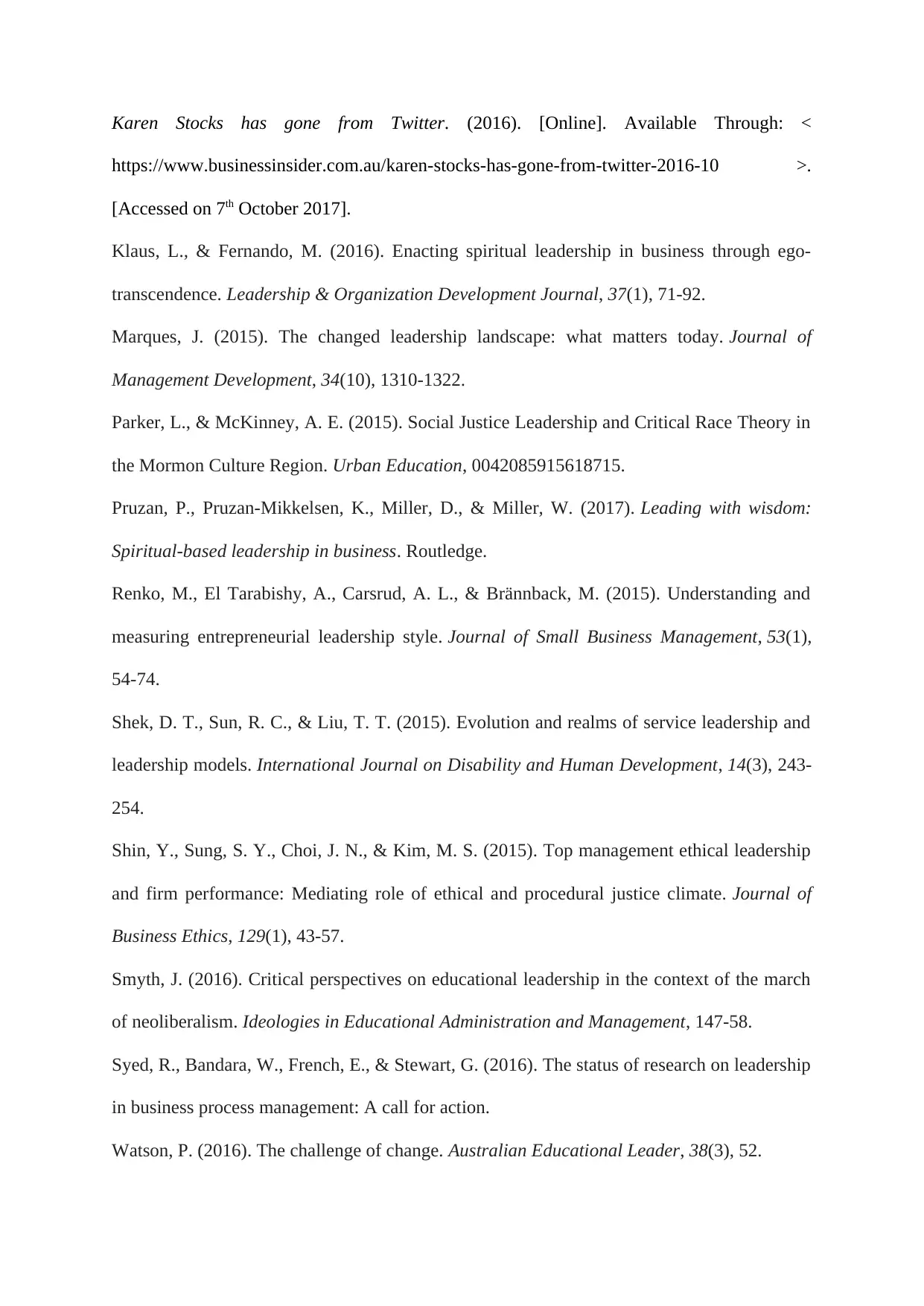
Karen Stocks has gone from Twitter. (2016). [Online]. Available Through: <
https://www.businessinsider.com.au/karen-stocks-has-gone-from-twitter-2016-10 >.
[Accessed on 7th October 2017].
Klaus, L., & Fernando, M. (2016). Enacting spiritual leadership in business through ego-
transcendence. Leadership & Organization Development Journal, 37(1), 71-92.
Marques, J. (2015). The changed leadership landscape: what matters today. Journal of
Management Development, 34(10), 1310-1322.
Parker, L., & McKinney, A. E. (2015). Social Justice Leadership and Critical Race Theory in
the Mormon Culture Region. Urban Education, 0042085915618715.
Pruzan, P., Pruzan-Mikkelsen, K., Miller, D., & Miller, W. (2017). Leading with wisdom:
Spiritual-based leadership in business. Routledge.
Renko, M., El Tarabishy, A., Carsrud, A. L., & Brännback, M. (2015). Understanding and
measuring entrepreneurial leadership style. Journal of Small Business Management, 53(1),
54-74.
Shek, D. T., Sun, R. C., & Liu, T. T. (2015). Evolution and realms of service leadership and
leadership models. International Journal on Disability and Human Development, 14(3), 243-
254.
Shin, Y., Sung, S. Y., Choi, J. N., & Kim, M. S. (2015). Top management ethical leadership
and firm performance: Mediating role of ethical and procedural justice climate. Journal of
Business Ethics, 129(1), 43-57.
Smyth, J. (2016). Critical perspectives on educational leadership in the context of the march
of neoliberalism. Ideologies in Educational Administration and Management, 147-58.
Syed, R., Bandara, W., French, E., & Stewart, G. (2016). The status of research on leadership
in business process management: A call for action.
Watson, P. (2016). The challenge of change. Australian Educational Leader, 38(3), 52.
https://www.businessinsider.com.au/karen-stocks-has-gone-from-twitter-2016-10 >.
[Accessed on 7th October 2017].
Klaus, L., & Fernando, M. (2016). Enacting spiritual leadership in business through ego-
transcendence. Leadership & Organization Development Journal, 37(1), 71-92.
Marques, J. (2015). The changed leadership landscape: what matters today. Journal of
Management Development, 34(10), 1310-1322.
Parker, L., & McKinney, A. E. (2015). Social Justice Leadership and Critical Race Theory in
the Mormon Culture Region. Urban Education, 0042085915618715.
Pruzan, P., Pruzan-Mikkelsen, K., Miller, D., & Miller, W. (2017). Leading with wisdom:
Spiritual-based leadership in business. Routledge.
Renko, M., El Tarabishy, A., Carsrud, A. L., & Brännback, M. (2015). Understanding and
measuring entrepreneurial leadership style. Journal of Small Business Management, 53(1),
54-74.
Shek, D. T., Sun, R. C., & Liu, T. T. (2015). Evolution and realms of service leadership and
leadership models. International Journal on Disability and Human Development, 14(3), 243-
254.
Shin, Y., Sung, S. Y., Choi, J. N., & Kim, M. S. (2015). Top management ethical leadership
and firm performance: Mediating role of ethical and procedural justice climate. Journal of
Business Ethics, 129(1), 43-57.
Smyth, J. (2016). Critical perspectives on educational leadership in the context of the march
of neoliberalism. Ideologies in Educational Administration and Management, 147-58.
Syed, R., Bandara, W., French, E., & Stewart, G. (2016). The status of research on leadership
in business process management: A call for action.
Watson, P. (2016). The challenge of change. Australian Educational Leader, 38(3), 52.

1 out of 15
Your All-in-One AI-Powered Toolkit for Academic Success.
+13062052269
info@desklib.com
Available 24*7 on WhatsApp / Email
![[object Object]](/_next/static/media/star-bottom.7253800d.svg)
Unlock your academic potential
© 2024 | Zucol Services PVT LTD | All rights reserved.

